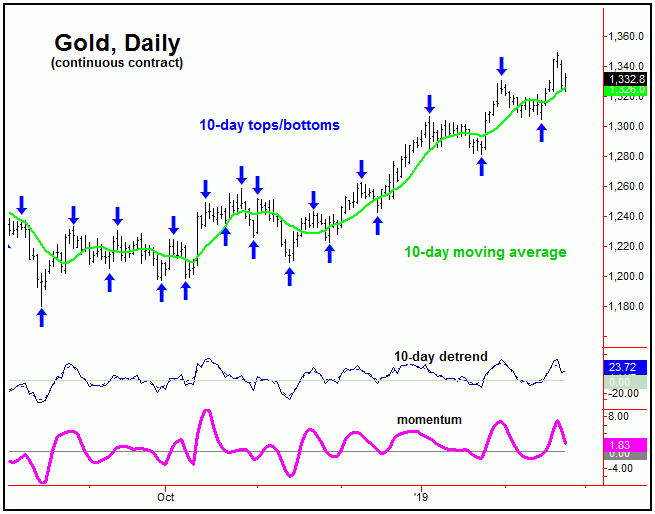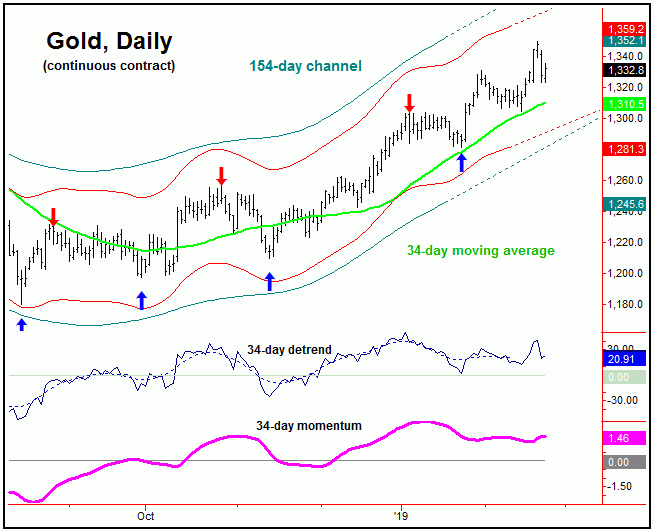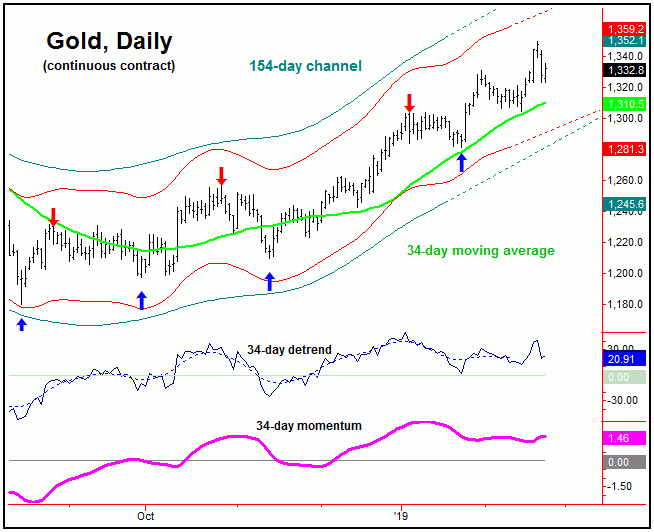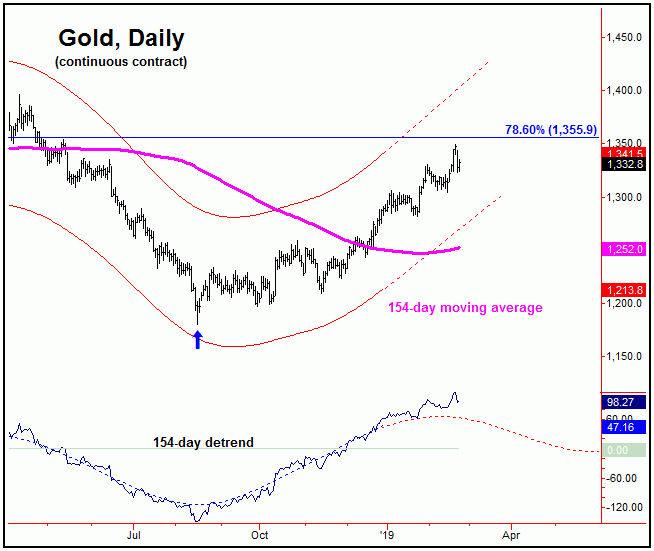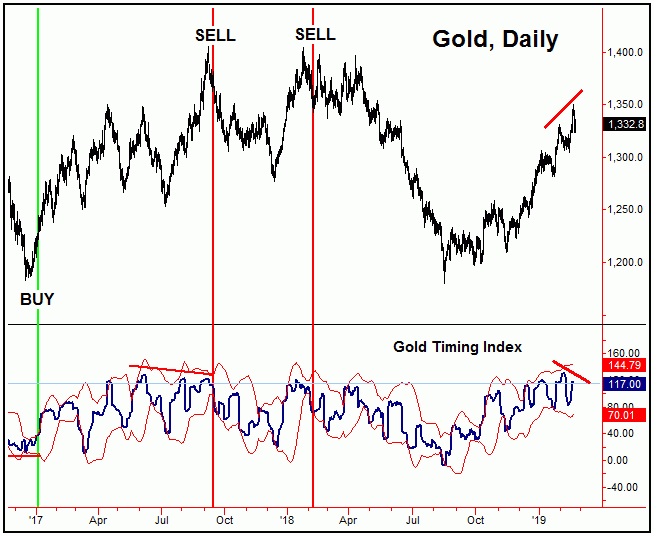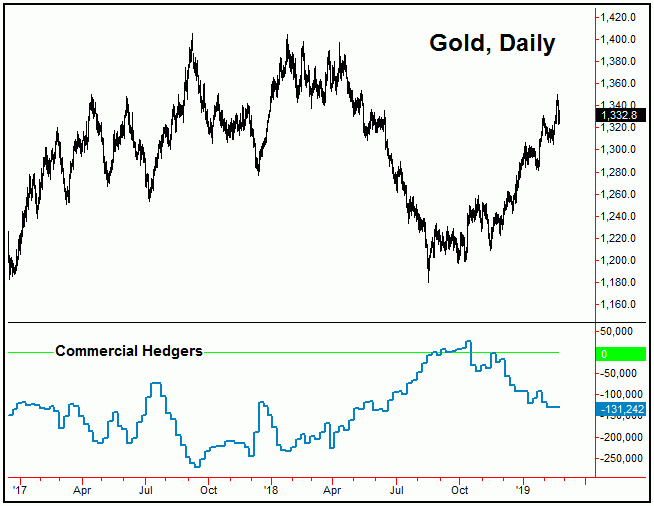Forecast: Gold Mid-Term Cycles Looking For A Peak

Gold witnessed a spirited move higher into mid-week, last week, with the metal running all the way up to a top of 1349.80 - made in Wednesday's session. From there, a sharp decline was seen into Thursday, here dropping down to a low of 1323.80 - before bouncing slightly off the same into the weekly close.
Reviewing the Recent Action
As mentioned in my prior article, the last smaller-degree correction came from the 10-day cycle, with that path calling for a drop back to or below the 10-day moving average for gold. We got that with the most recent downward phase, with the metal dropping down to a low of 1304.70, on a bottom registered back on 2/14/19. Here again is that 10-day cycle:
In terms of patterns, due to the configuration of our Gold Timing Index - as well as the currently-viewed position of the larger 34, 72 and 154-day cycles - the overall assumption was that last correction phase of the 10-day cycle would end up as a countertrend affair, holding above the 1281.50 swing low. From there, the reversal back above the 1322.00 figure (seen on 1/15/19) confirmed the 10-day wave to have troughed.
Going further with the above, the countertrend decline with the 10-day cycle was expected to give way to a push back above the 1330.10 swing top - but with at least the potential for a try at key resistance at the 1355 figure (78% retracement) would materialize. gold made a hard attempt at this key level early in last week's trading - rising as high as 1349.80 - before selling down off the same into late-week.
Medium-Term Outlook
Going further with the above, the current upward phase of the 34-day cycle made it to higher highs into last week, which was easily forecast by the time cycles. The current upward phase of this wave should be the one that tops the larger 154-day component, for what is anticipated to be a mid-term decline phase into mid-to-late Spring (April or May). Here again is our 34-day time cycle, in chart format:
In terms of price, as mentioned in past articles, there is a decent amount of resistance to the current upward phase around the 1355 level (plus or minus)- which is the 78% retracement of the last 154-day downward phase, from the January, 2018 peak to the August, 2018 low. Having said that, though there is no way to know what price figure will actually top this mid-term upward phase, though - with the selling into late-week - there is at least some potential that it could already have peaked with the recent tag of 1349.80. However, it is too early to confirm the same, and thus there is the same potential for higher highs still out there.
In our Gold Wave Trader market report, we do have a key downside reversal level, which - if taken out to the downside - would be our best indication/confirmation that the mid-term upward phase is complete, and that a decline into the next mid-term trough is in progress. In terms of time, the next 154-day cycle bottom is anticipated to occur around the late-April to late-May timeframe, but with a large average variance in either direction - due to the size of this 154-day component.
Stepping back then, the next mid-term peak is expected to come from the 154-day cycle. Once the next peak is in place with this wave, then, as noted in past weeks, the probabilities will favor a decent decline phase playing out, one which sees the 154-day moving average or lower acting as the minimum magnet - but with the obvious potential for additional follow-through below the same. Having said that, that decline is currently favored to end up as a countertrend affair - against the August, 2018 bottom of 1179. If correct, another sharp rally phase is expected to play out into the Summer months. Here again is a look at our 154-day cycle:
As noted above, the next downward phase of this 154-day cycle is expected to take gold back or below its rising 154-day moving average; this will be seen on approximately 85% of the downward phases of this wave - as per my rule in regards to cycles and moving averages. However, the metal will normally see additional follow-through below the same, though the patterns do tend to favor any mid-term decline to end up as countertrend. If correct, another push back to higher highs is likely to play out into the Summer months, before a secondary low takes hold into late-Summer/early-Autumn.
For the bigger picture, it is too early to give the exact details of how the price action will play out into mid-to-late Summer, though both the seasonal patterns - as well as the time cycles - should line up for a sharp rally into late-2019 and/or the first few months of 2020. As more of a side note, seasonal patterns for gold are different to that seen in the stock market, where gold is more bullish from mid-August through mid-February, with the seasonal bearish period lasting from mid-February through that same mid-August period.
Gold Timing Index
The chart below updates our Gold Timing Index, which, as noted many times in prior articles, is our best indicator of mid-term trend direction for gold:
In looking at the chart above, of note is that our Gold Timing Index is now diverging against the recent new price high. As noted in past reports, this divergence is the initial setup for a mid-term sell signal for gold. Having said that, in order for this sell signal to actually trigger, the indicator would need to close below its lower standard-deviation band, which it is obviously well away from right now - and gold would likely need to see additional price decline for this pattern to occur. Also, a close below our standard-deviation band may or may not occur. That is, it is also possible that this indicator will follow price to a higher high - thus negating this setup. This is something that we will tracking very closely in our thrice-weekly Gold Wave Trader report.
Gold Sentiment
In looking at sentiment indications for the gold market, the latest COT numbers now show the commercial hedgers (chart, above) now holding 131,242 shorts, with this data up-to-date to the 2/5/19 close. Though this data is still several weeks old (due to the CFTC's current reporting schedule), I do see the position of the hedgers as being a bearish indication going forward - particularly if they should continue to add to the same in the coming weeks.
On the flip side to the above, I should quickly add that - at the larger-degree peaks seen back in September, 2018 and January, 2018, the commercial hedgers held much larger short positions - well over 200,000 contracts each time - as opposed to the more modest reading of some 131,000 contracts. Having said that, with this data several weeks old, there is the potential that they have continued to add in recent weeks, and we won't get back to real-time reporting until the first week or two of March. More on this as we continue to move forward.
Jim Curry
The Gold Wave Trader
http://goldwavetrader.com/
http://cyclewave.homestead.com/
********

